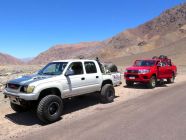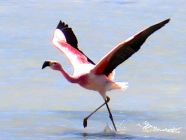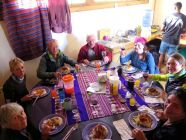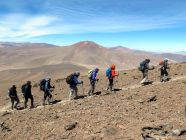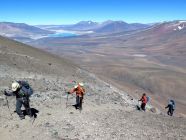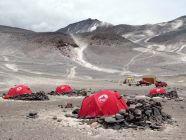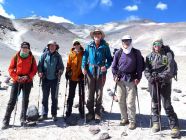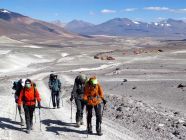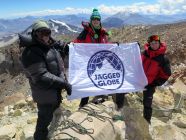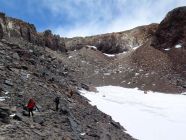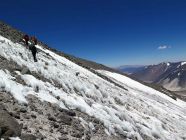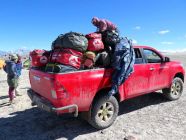'A great way to escape the UK winter weather and have a climbing adventure in the South American sunshine' sums up the Xmas / New Year trip to 6,893m Ojos del Salado, Chile's highest mountain.
Our international team of seven climbers from UK, USA, South Africa & Russia assembled in Copiapo, capital of the Atacama region, on 19th December 2019. We were met by local guide Paula, a veteran of 27 previous ascents of Ojos, and her four-member team of drivers and cooks in three 4WD 'trucks'. Over the next two weeks we travelled on empty mountain roads, crossed high passes, slept under bright star lit skies, watched flamingos feeding in salt lakes, trekked up an 'easy' 6,000m peak, and climbed a not so 'easy' mountain.
Every high altitude climbing expedition is different, but most of the Asian/Himalayan peaks share a lot of similar elements. South American expeditions are different, with easy road access to high altitudes, but far fewer peaks reaching almost 7,000m. What makes Ojos exceptional is that it is a very high peak located in one of the world's driest deserts. The unique landscape of the Atacama draws tourists from all over the world who marvel at the salt lakes, steaming geysers, and surreal geological features. Amateur stargazers and professional astronomers come to stare at the heavens, and the region is home to some of the largest telescopes on Earth. However the harsh landscapes see few climbing or trekking expeditions due to the challenges of travelling and living in an area devoid of any drinkable water.
A few species of birds and animals have adapted to life in this arid region. During our stay we saw large flocks of flamingos in several of the salt lakes, as well as other types of migratory birds. Vicuñas and guanacos appeared from time to time, but we were never quite sure how to tell the two species apart. Sightings of a solitary fox and a (rabbit like) viscacha meant that we saw all the wildlife in the Atacama tourist brochure except the elusive puma.
The aim for the first half of the expedition was to enable the team to acclimatise to the high altitude and thin air of the mountains. With drivable tracks reaching up to almost 6,000m the greatest danger was driving too high, too quickly, before people were fully ready. We stayed in a small private Refugio overlooking Laguna Santa Rosa (3,789m) and hiked to the top of Maricunga Peak (4,885m). Then we relocated to set up camp on the shores of the salty Laguna Verde (4,300m) where we spent four nights beside a natural thermal spring. We hiked the 21km circumference of the lakeshore, spending a long day in a salt encrusted landscape. On Christmas day we made an early start to climb Nevado de San Francisco (6,018m) on the Chile / Argentina border. Later we found time for a brief dip in the cold lake and a longer soak in the hot springs close to the shore.
Throughout we were increasingly impressed with the camp services provided by Paula and her team. The 3 trucks had looked quite heavily laden when we left Copiapo and we soon learnt why. In addition to carrying several hundred litres of drinking water and jerry cans of extra fuel we had a large dining tent with comfortable chairs, colourful tablecloths, real plates and proper wine glasses. Then there was the food! Chief cook Camilla, a cake and desert specialist from Mendoza, was assisted by her partner (and driver) Facha plus Christian. Between them they turned out an amazing variety of food featuring fresh fruit, vegetables, fish, and meat, accompanied by wine and/or beer. The Christmas Day BBQ, with festive decorations, pork ribs, beefsteak, and whole chickens was just one example of their remarkable meals.
By 27th December we ready to drive up to 'Atacama Camp' (5,200m) the basecamp for Ojos del Salado. There were no other climbers in camp and we had the pick of the best tent sites, protected by low stone walls from the occasional fierce winds. A 'there and back' hike up to Refugio Tejos (5,825m) showed that all the team members were in good form. So we moved the planned summit day forward to the 30th to take advantage of a good weather forecast and ensure sole occupancy of the small Refugio.
Not surprisingly for a desert, there was no rain during our trip. However, most afternoons were windy and on some days thick clouds formed over the highest peaks. All the acclimatisation hikes had been in daylight with reasonably warm conditions. The climb to Ojos summit was very different. We were the only people climbing to the summit on the 30th and were pleased to have the mountain to ourselves. We managed an efficient start at 02.00hrs after a good breakfast and made steady progress in mild conditions for the first few hours. Then, despite little wind, the temperature fell considerably and the climb became very cold until well after dawn. Double boots, big jackets, warm hats and mittens that had been underused to this point were suddenly very welcome. The trail zig-zagged up a fairly uniform slope of around 25 degrees. The surface underfoot was a mix of gravel and scree, comprising small lumps of volcanic ash and lava.
First light came around 06.00hrs but it was not until a few hours later that the air temperature rose above zero. Eventually we reached the crater rim at 6,750m and were able to enjoy a brief rest on level ground. The frozen crater lake lay a few meters ahead and the summit rock tower soared above. The nature of the climbing changed: a long horizontal traverse gave way to a steep boulder slope leading to a short steep rock chimney, equipped with a 15m fixed rope. Ascending the final rope section took a little time and by 11.30hrs we were standing on the summit of Ojos del Salado, nine and a half hours after starting out. The sky was clear and there was little wind. We were rewarded with great views of the many 6,000m plus peaks along the Chile / Argentina border. The descent was much quicker than the ascent and we were all back at Ref Tejos by 15.00hrs, completing a 13 hour climb.
Back at basecamp the cook team prepared another fantastic meal, with a bottle of champagne, to celebrate our climb and we retired to bed around 20.00hrs after an 18-hour day. The next morning we packed all the basecamp kit onto the three trucks and set off for lower altitudes. With a few days in hand we were able to leave the mountains ahead of schedule and drive to Copiapo for hot showers and rather muted New Year celebrations, as town seemed to have closed entirely for the holiday season. The next day we relocated to the beach at Bahia Inglesa for a day of sea views and seafood feasts. We enjoyed fresh fish, cerviche, scallops, squid and octopus overlooking a sandy beach and marvelling that we had managed to drop from almost 7,000m to sea level in a few short days. Not many high altitude climbing trips end on a beach!
All too soon it was onward to Copiapo airport and a final group meal in Santiago before the team boarded separate flights to different corners of the globe. On reflection we managed to pack a lot into to a two week trip in a fascinating part of the world. The desert and salt lake landscape was a new experience for all of us, and the ascent of Ojos just hard enough to ensure that none of us will ever call it an 'easy' climb.
David Hamilton, Santiago, 5th January 2020

